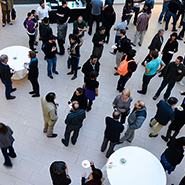Vision and Goals
The goal of this thrust is to characterize in more precise computational terms the content of the systems underlying nonverbal social perception (NVSP), and how they arise through mechanisms of learning and development.
Approach
Short video clips of real people will be used to evaluate NVSP. Subjects will judge the presence or intentions of an agent, presence and nature of an interaction, nature of the relationship, and group membership structure of three or more agents. The neural basis of NVSP will be investigated with psychophysical methods, computational theory, fMRI, and other brain based methods in adult and developing humans. Psychophysical methods will help to analyze the perceptual cues supporting each social inference, providing a precise, quantitative, and analytical characterization of perceptual abilities inherent in this NVSP task. Specifically, subjects will be tested on altered versions of the original video in which a principled subset of the stimulus information has been isolated or filtered. Computational Theory will help determine the representations and algorithms that enable rich information to be extracted quickly from short image sequences. We hypothesize that core machinery is shared with infants’ intuitive psychology, and characterize adults’ social perception using the same basic approach of Bayesian inference over probabilistic models of intentional agents as boundedly rational planners as described in the Development of Intelligence Research Thrust. To study the development of social perception, psychophysical tasks will be adapted for children from the youngest age possible through the early teens. Some studies will apply standard fMRI methods to test aspects of NVSP thought to be distinct based on data obtained with other approaches. We will also apply newer data-driven methods (e.g., clustering) to discover structure in the brain’s response to large sets of movie clips. We will obtain scans of 6-month-old human infants viewing social movies in an improved version of our specialized infant coil/recliner designed for high signal to noise ratio. TMS studies in adults may be used to test the causal role of subregions of the superior temporal sulcus (STS) in NVSP and related abilities. Diffusion-weighted imaging will identify connections between distinct STS subregions, and with the rest of the brain. We may also conduct fMRI studies on NVSP in macaques.
Integration
Connections to The Development of Intelligence Research Thrust include the computational analyses of nonverbal social perception in infants and adults, and how these competences develop. Work with social stimuli (faces) in the Circuits for Intelligence Research Thrust connects with the human fMRI and macaque models of nonverbal social perception. High-level perceptual representations examined within the Vision and Language Research Thrust, and models of the social and physical world, are closely connected to this thrust.

 Social cognition is at the core of human intelligence. It is through social interactions that we learn. We believe that social interactions drove much of the evolution of the human brain. Indeed, the neural machinery of social cognition comprises a substantial proportion of the brain. The greatest feats of the human intellect are often the product not of individual brains, but people working together in social groups. Thus, intelligence simply cannot be understood without understanding social cognition. Yet we have no theory or even taxonomy of social intelligence, and little understanding of the underlying brain mechanisms, their development, or the computations they perform. Here we bring developmental, computational, and cognitive neuroscience approaches to bear on a newly tractable component of social intelligence: nonverbal social perception (NVSP), which is the ability to discern rich multidimensional social information from a few seconds of a silent video.
Social cognition is at the core of human intelligence. It is through social interactions that we learn. We believe that social interactions drove much of the evolution of the human brain. Indeed, the neural machinery of social cognition comprises a substantial proportion of the brain. The greatest feats of the human intellect are often the product not of individual brains, but people working together in social groups. Thus, intelligence simply cannot be understood without understanding social cognition. Yet we have no theory or even taxonomy of social intelligence, and little understanding of the underlying brain mechanisms, their development, or the computations they perform. Here we bring developmental, computational, and cognitive neuroscience approaches to bear on a newly tractable component of social intelligence: nonverbal social perception (NVSP), which is the ability to discern rich multidimensional social information from a few seconds of a silent video.